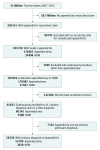Nonoperative Management of Uncomplicated Appendicitis Among Privately Insured Patients
- PMID: 30427983
- PMCID: PMC6439669
- DOI: 10.1001/jamasurg.2018.4282
Nonoperative Management of Uncomplicated Appendicitis Among Privately Insured Patients
Abstract
Importance: Health care professionals have shown significant interest in nonoperative management for uncomplicated appendicitis, but long-term population-level data are lacking.
Objective: To compare the outcomes of nonoperatively managed appendicitis against appendectomy.
Design, setting, and participants: This national retrospective cohort study used claims data from a private insurance database to compare patients admitted with uncomplicated appendicitis from January 1, 2008, through December 31, 2014, undergoing appendectomy vs nonoperative management. Coarsened exact matching was applied before multivariate analysis to reduce imbalance between groups. Data were analyzed from February 12 through May 1, 2018.
Exposures: Appendectomy (control arm) or nonoperative management (treatment arm).
Main outcomes and measures: Short-term primary clinical outcomes included emergency department visits, hospital readmission, abdominal abscess, and Clostridium difficile infections. Long-term primary clinical outcomes were small-bowel obstructions, incisional hernias, and appendiceal cancers. Nonoperative management failure was defined by hospital readmission with appendicitis diagnosis and an appendicitis-associated operation or procedure. Secondary outcomes included number of follow-up visits, length and cost of index hospitalization, and total cost of appendicitis-associated care. Covariates included age, sex, region, insurance plan type, admission year, and Charlson comorbidity index.
Results: Of 58 329 patients with uncomplicated appendicitis (52.7% men; mean [SD] age, 31.9 [16.5] years), 55 709 (95.5%) underwent appendectomy and 2620 (4.5%) underwent nonoperative management. Patients in the nonoperative management group were more likely to have appendicitis-associated readmissions (adjusted odds ratio, 2.13; 95% CI, 1.63-2.77; P < .001) and to develop an abscess (adjusted odds ratio, 1.42; 95% CI, 1.05-1.92; P = .02). Patients in the nonoperative management group required more follow-up visits in the year after index admission (unadjusted mean [SD], 1.6 [6.3] vs 0.3 [1.4] visits; adjusted +1.11 visits; P < .001) and had lower index hospitalization cost (unadjusted mean [SD], $11 502 [$9287] vs $13 551 [$10 160]; adjusted -$2117, P < .001), but total cost of appendicitis care was higher when follow-up care was considered (unadjusted, $14 934 [$31 122] vs $14 186 [$10 889]; adjusted +$785; P = .003). During a mean (SD) of 3.2 (1.7) years of follow-up, failure of nonoperative management occurred in 101 patients (3.9%); median time to recurrence was 42 days (interquartile range, 8-125 days). Among the patients who experienced treatment failure, 44 did so within 30 days.
Conclusions and relevance: According to results of this study, nonoperative management failure rates were lower than previously reported. Nonoperative management was associated with higher rates of abscess, readmission, and higher overall cost of care. These data suggest that nonoperative management may not be the preferred first-line therapy for all patients with uncomplicated appendicitis.
Conflict of interest statement
Figures



Comment in
-
Treating the Patient With Appendicitis, Not Just the Appendicitis.JAMA Surg. 2019 Feb 1;154(2):149. doi: 10.1001/jamasurg.2018.4300. JAMA Surg. 2019. PMID: 30427979 Free PMC article. No abstract available.
-
Questioning the Higher Abscess Rate and Overall Cost of Care Associated With Nonoperative Management of Uncomplicated Acute Appendicitis.JAMA Surg. 2019 Aug 1;154(8):784. doi: 10.1001/jamasurg.2019.1161. JAMA Surg. 2019. PMID: 31090883 No abstract available.
-
Questioning the Higher Abscess Rate and Overall Cost of Care Associated With Nonoperative Management of Uncomplicated Acute Appendicitis-Reply.JAMA Surg. 2019 Aug 1;154(8):784-785. doi: 10.1001/jamasurg.2019.1162. JAMA Surg. 2019. PMID: 31090887 No abstract available.
Similar articles
-
Association of Health Care Utilization With Rates of Perforated Appendicitis in Children 18 Years or Younger.JAMA Surg. 2018 Jun 1;153(6):544-550. doi: 10.1001/jamasurg.2017.5316. JAMA Surg. 2018. PMID: 29387882 Free PMC article.
-
Association of Nonoperative Management Using Antibiotic Therapy vs Laparoscopic Appendectomy With Treatment Success and Disability Days in Children With Uncomplicated Appendicitis.JAMA. 2020 Aug 11;324(6):581-593. doi: 10.1001/jama.2020.10888. JAMA. 2020. PMID: 32730561 Free PMC article. Clinical Trial.
-
The Unintended Consequences of Nonoperative Management of Acute Appendicitis.J Surg Res. 2020 Nov;255:436-441. doi: 10.1016/j.jss.2020.05.018. Epub 2020 Jun 30. J Surg Res. 2020. PMID: 32619858
-
Comparing Antibiotics and Surgery to Treat Appendicitis in Children [Internet].Washington (DC): Patient-Centered Outcomes Research Institute (PCORI); 2021 May. Washington (DC): Patient-Centered Outcomes Research Institute (PCORI); 2021 May. PMID: 38556973 Free Books & Documents. Review.
-
Nonoperative vs Operative Management of Uncomplicated Acute Appendicitis: A Systematic Review and Meta-analysis.JAMA Surg. 2022 Sep 1;157(9):828-834. doi: 10.1001/jamasurg.2022.2937. JAMA Surg. 2022. PMID: 35895073 Free PMC article.
Cited by
-
The Conditional Effects of Multimorbidity on Operative Versus Nonoperative Management of Emergency General Surgery Conditions: A Retrospective Observational Study Using an Instrumental Variable Analysis.Ann Surg. 2023 Oct 1;278(4):e855-e862. doi: 10.1097/SLA.0000000000005901. Epub 2023 May 22. Ann Surg. 2023. PMID: 37212397 Free PMC article.
-
Non-operative management of uncomplicated appendicitis in children, why not? A meta-analysis of randomized controlled trials.World J Emerg Surg. 2025 Mar 25;20(1):25. doi: 10.1186/s13017-025-00584-9. World J Emerg Surg. 2025. PMID: 40133910 Free PMC article.
-
Acute appendicitis severity during the early COVID-19 pandemic period.Trauma Surg Acute Care Open. 2021 Aug 26;6(1):e000809. doi: 10.1136/tsaco-2021-000809. eCollection 2021. Trauma Surg Acute Care Open. 2021. PMID: 34466662 Free PMC article.
-
Interhospital variation in the nonoperative management of acute cholecystitis.PLoS One. 2024 Jun 10;19(6):e0300851. doi: 10.1371/journal.pone.0300851. eCollection 2024. PLoS One. 2024. PMID: 38857278 Free PMC article.
-
The Impact of the Coronavirus Disease - 19 Pandemic on the Clinical Characteristics and Treatment of Adult Patients with Acute Appendicitis.Front Surg. 2022 Mar 31;9:878534. doi: 10.3389/fsurg.2022.878534. eCollection 2022. Front Surg. 2022. PMID: 35433818 Free PMC article.
References
-
- Wilms IM, de Hoog DE, de Visser DC, Janzing HM. Appendectomy versus antibiotic treatment for acute appendicitis. Cochrane Database Syst Rev. 2011;(11):CD008359. - PubMed
Publication types
MeSH terms
LinkOut - more resources
Full Text Sources
Medical

